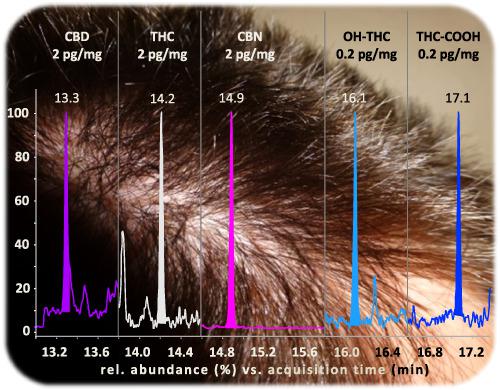当前位置:
X-MOL 学术
›
Drug Test. Anal.
›
论文详情
Our official English website, www.x-mol.net, welcomes your
feedback! (Note: you will need to create a separate account there.)
Simultaneous quantification of THC‐COOH, OH‐THC, and further cannabinoids in human hair by gas chromatography–tandem mass spectrometry with electron ionization applying automated sample preparation
Drug Testing and Analysis ( IF 2.6 ) Pub Date : 2018-09-25 , DOI: 10.1002/dta.2490 Tobias Kieliba 1 , Oliver Lerch 2 , Hilke Andresen-Streichert 1 , Markus A. Rothschild 1 , Justus Beike 1
Drug Testing and Analysis ( IF 2.6 ) Pub Date : 2018-09-25 , DOI: 10.1002/dta.2490 Tobias Kieliba 1 , Oliver Lerch 2 , Hilke Andresen-Streichert 1 , Markus A. Rothschild 1 , Justus Beike 1
Affiliation

|
The detection of Δ9‐tetrahydrocannabinol (THC), cannabidiol (CBD) and cannabinol (CBN) in hair, for the purpose of identifying cannabis consumption, is conducted in many forensic laboratories. Since external contamination of hair with these cannabis components cannot be excluded, even after hair decontamination, only the detection of THC metabolites such as 11‐nor‐9‐carboxy‐Δ9‐tetrahydrocannabinol (THC‐COOH) or 11‐hydroxy‐Δ9‐tetrahydrocannabinol (OH‐THC), is considered to prove cannabis consumption. At present, testing for THC metabolites is not standard practice due to its analytical complexity. For these reasons, we developed a novel method for the detection of THC‐COOH and OH‐THC as well as THC, CBD, and CBN in one single analytical run using gas chromatography–tandem mass spectrometry (GC–MS/MS) with electron ionization. After manual hair washing and grinding, sample preparation was fully automated, by means of a robotic autosampler. The hair extraction took place by digestion with sodium hydroxide. A solid‐phase extraction (SPE) was chosen for sample clean‐up, using a mixed‐mode anion exchange sorbent. Derivatization of all analytes was by silylation. The method has been fully validated according to guidelines of the Society of Toxicological and Forensic Chemistry (GTFCh), with a limit of detection (LOD) of 0.2 pg/mg for THC‐COOH and OH‐THC and 2 pg/mg for THC, CBD and CBN, respectively, thus fulfilling the Society of Hair Testing (SoHT) recommendations. The validated method has been successfully applied to our routine forensic case work and a summary of data from authentic hair samples is given, as well as data from proficiency tests.
中文翻译:

气相色谱-串联质谱联用电子离子化技术通过自动样品制备技术同时定量人发中的四氢大麻酚-四氢大麻酚,OH-THC和其他大麻素
Δ的检测9四氢大麻酚在毛发(THC),大麻二酚(CBD)和大麻酚(CBN),用于识别大麻消费的目的,在许多法医实验室进行。由于头发与这些大麻部件外部污染不能排除,即使头发去污后,仅THC的检测代谢物如11-去甲-9-羧基- Δ 9 -四氢大麻酚(THC-COOH)或11-羟基Δ 9四氢大麻酚(OH-THC)被认为可证明大麻消费量。目前,由于四氢大麻酚代谢物的分析复杂性,测试还不是标准方法。出于这些原因,我们开发了一种新方法,可使用带有电子的气相色谱-串联质谱(GC-MS / MS)进行单个分析运行中的THC-COOH和OH-THC以及THC,CBD和CBN的检测方法。电离。手动洗发和打磨后,借助自动进样器实现了样品制备的完全自动化。通过用氢氧化钠消化来进行毛发提取。使用混合模式阴离子交换吸附剂,选择了固相萃取(SPE)进行样品净化。所有分析物的衍生化都是通过甲硅烷基化。该方法已根据毒理学和法医学会(GTFCh)的指南进行了充分验证,THC-COOH和OH-THC的检出限(LOD)为0.2 pg / mg,THC的检出限为2 pg / mg, CBD和CBN分别满足了头发测试协会(SoHT)的建议。经过验证的方法已成功应用于我们的常规法医案例研究,并给出了来自真实头发样本的数据摘要以及来自能力验证的数据摘要。
更新日期:2018-09-25
中文翻译:

气相色谱-串联质谱联用电子离子化技术通过自动样品制备技术同时定量人发中的四氢大麻酚-四氢大麻酚,OH-THC和其他大麻素
Δ的检测9四氢大麻酚在毛发(THC),大麻二酚(CBD)和大麻酚(CBN),用于识别大麻消费的目的,在许多法医实验室进行。由于头发与这些大麻部件外部污染不能排除,即使头发去污后,仅THC的检测代谢物如11-去甲-9-羧基- Δ 9 -四氢大麻酚(THC-COOH)或11-羟基Δ 9四氢大麻酚(OH-THC)被认为可证明大麻消费量。目前,由于四氢大麻酚代谢物的分析复杂性,测试还不是标准方法。出于这些原因,我们开发了一种新方法,可使用带有电子的气相色谱-串联质谱(GC-MS / MS)进行单个分析运行中的THC-COOH和OH-THC以及THC,CBD和CBN的检测方法。电离。手动洗发和打磨后,借助自动进样器实现了样品制备的完全自动化。通过用氢氧化钠消化来进行毛发提取。使用混合模式阴离子交换吸附剂,选择了固相萃取(SPE)进行样品净化。所有分析物的衍生化都是通过甲硅烷基化。该方法已根据毒理学和法医学会(GTFCh)的指南进行了充分验证,THC-COOH和OH-THC的检出限(LOD)为0.2 pg / mg,THC的检出限为2 pg / mg, CBD和CBN分别满足了头发测试协会(SoHT)的建议。经过验证的方法已成功应用于我们的常规法医案例研究,并给出了来自真实头发样本的数据摘要以及来自能力验证的数据摘要。





























 京公网安备 11010802027423号
京公网安备 11010802027423号